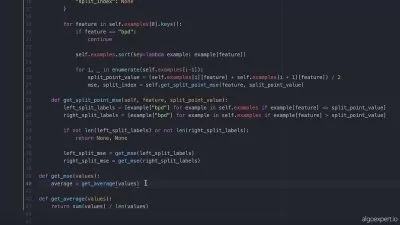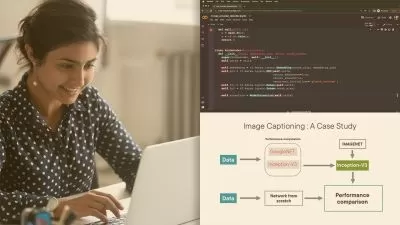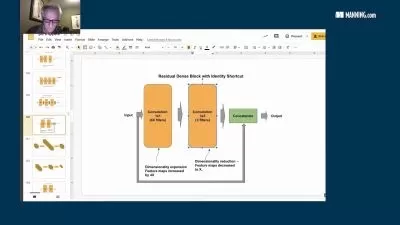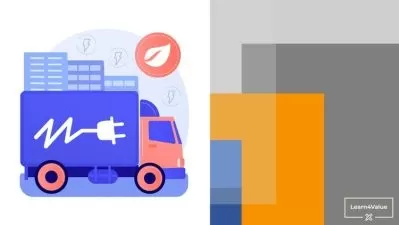Supply Chain Analysis with Machine Learning & Neural Network
Christ Raharja
3:10:48
Description
Learn how to analyse supply chain data using LightGBM and Recurrent Neural Network
What You'll Learn?
- Learn how to do supply chain risk assessment analysis to mitigate potential supply chain disruption risks
- Learn how to do inventory optimization analysis using Economic Order Quantity
- Learn how to do customer segmentation analysis by breaking down generated revenue by its customer demographics
- Learn how to forecast customer demand using LightGBM model
- Learn how to do K-Fold Cross Validation method to evaluate the performance of LightGBM forecasting model
- Learn how to do cost optimization analysis using Recurrent Neural Network model
- Learn how to do lead time optimization analysis to find the most optimal transportation mode and route
- Learn how to do quality control check by analyzing defect rate for each product type
- Learn several factors that can potentially cause supply chain disruptions, such as natural disaster, economic volatility, tariff and trade barriers
- Learn how to do inventory and order quantity optimization analysis using EOQ (Economic Order Quantity)
- Learn how to do cost optimization analysis using TCO (Total Cost of Ownership) method
Who is this for?
What You Need to Know?
More details
DescriptionWelcome to Supply Chain Analysis with Machine Learning & Neural Network course. This is a comprehensive project based course where you will learn step by step on how to perform complex analysis and visualization on supply chain dataset. This course will be mainly focusing on performing cost optimization, demand forecasting, lead time efficiency, risk management, and order quantity optimization. We will be utilizing two different models, those are LightGBM which is a machine learning model and RNN which stands for Recurrent Neural Networks. Regarding programming language, we are going to use Python alongside several libraries like Pandas for performing data modelling, Numpy for performing complex calculations, Matplotlib for visualizing the data, and Scikit-learn for implementing the machine learning models.Meanwhile, for the data, we are going to download the supply chain dataset from Kaggle. In the introduction session, you will learn basic fundamentals of supply chain analytics, such as getting to know its key objectives, getting to know models that will be used, and challenges that we commonly faced when it comes to analyzing supply chain data for example demand volatility and data integration. Then, you will continue by learning the basic mathematics and logics behind price and order quantity optimization where you will be guided step by step on how to solve a basic case study using economic order quantity equation. This session was designed to prepare your knowledge and understanding about order quantity optimization before implementing this concept to your code in the project. Afterward, you will learn about several different factors that can potentially cause supply chain disruption, such as natural disaster, economic volatility, and supplier issues. Once you’ve learnt all necessary knowledge about supply chain analytics, we will start the project. Firstly, you will be guided step by step on how to set up Google Colab IDE, then, you will also learn how to find and download datasets from Kaggle. Once everything is all set, you will enter the main section of the course which is the project section. The project will consist of two main parts where in the first part you will use machine learning specifically the LightGBM algorithm while in the second part, you will use Recurrent Neural Network. Lastly, at the end of the course, you will also learn how to evaluate the accuracy of the models that you built in the project using the K-fold cross validation method.
First of all, before getting into the course, we need to ask this question to ourselves: why should we analyze supply chain data with machine learning and neural networks? Well, there are a lot of answers to that question. Firstly, supply chain is undeniably one of the most important factors in business operation. Let me give you an example, let’s say you have an E-commerce business and you rely only on one supplier and one day, your supplier decided to stop producing the product, what would be your strategy to survive if that is the case. Or let’s talk about another example where you tried to optimize your logistic cost and decided to ship your product to your customers using one freight forwarder because it offers the cheapest fee, nonetheless, you did not realize that actually the freight forwarder does not have the ability to handle your requested capacity, if that is the case, what would be your solution and there are still a lot of complex cases like those in supply chain. Therefore, by utilizing machine learning and neural networks, we will be able to solve those kinds of problems and find the best solutions possible.
Below are things that you can expect to learn from this course:
Learn basic fundamentals of supply chain analytics, such as getting to know its key objectives and several challenges commonly faced when analyzing supply chain data
Learn how to do cost optimization analysis using TCO (Total Cost of Ownership) method
Learn how to do inventory and order quantity optimization analysis using EOQ (Economic Order Quantity)
Learn several factors that can potentially cause supply chain disruptions, such as natural disaster, economic volatility, tariff and trade barriers
Learn how to find and download datasets from Kaggle
Learn how to clean dataset by removing missing rows and duplicate values
Learn how to do quality control check by analyzing defect rate for each product type
Learn how to do supply chain risk assessment analysis to mitigate potential supply chain disruption risks
Learn how to do inventory optimization analysis using Economic Order Quantity
Learn how to do customer segmentation analysis by breaking down generated revenue by its customer demographics
Learn how to do lead time optimization analysis to find the most optimal transportation mode and route
Learn how to forecast customer demand using LightGBM model
Learn how to do cost optimization analysis using Recurrent Neural Network model
Learn how to do K-Fold Cross Validation method to evaluate the performance of LightGBM forecasting model
Who this course is for:
- People who are interested in analysing supply chain data using machine learning and neural network
- People who are interested in learning how to optimise cost, lead times, and inventory
Welcome to Supply Chain Analysis with Machine Learning & Neural Network course. This is a comprehensive project based course where you will learn step by step on how to perform complex analysis and visualization on supply chain dataset. This course will be mainly focusing on performing cost optimization, demand forecasting, lead time efficiency, risk management, and order quantity optimization. We will be utilizing two different models, those are LightGBM which is a machine learning model and RNN which stands for Recurrent Neural Networks. Regarding programming language, we are going to use Python alongside several libraries like Pandas for performing data modelling, Numpy for performing complex calculations, Matplotlib for visualizing the data, and Scikit-learn for implementing the machine learning models.Meanwhile, for the data, we are going to download the supply chain dataset from Kaggle. In the introduction session, you will learn basic fundamentals of supply chain analytics, such as getting to know its key objectives, getting to know models that will be used, and challenges that we commonly faced when it comes to analyzing supply chain data for example demand volatility and data integration. Then, you will continue by learning the basic mathematics and logics behind price and order quantity optimization where you will be guided step by step on how to solve a basic case study using economic order quantity equation. This session was designed to prepare your knowledge and understanding about order quantity optimization before implementing this concept to your code in the project. Afterward, you will learn about several different factors that can potentially cause supply chain disruption, such as natural disaster, economic volatility, and supplier issues. Once you’ve learnt all necessary knowledge about supply chain analytics, we will start the project. Firstly, you will be guided step by step on how to set up Google Colab IDE, then, you will also learn how to find and download datasets from Kaggle. Once everything is all set, you will enter the main section of the course which is the project section. The project will consist of two main parts where in the first part you will use machine learning specifically the LightGBM algorithm while in the second part, you will use Recurrent Neural Network. Lastly, at the end of the course, you will also learn how to evaluate the accuracy of the models that you built in the project using the K-fold cross validation method.
First of all, before getting into the course, we need to ask this question to ourselves: why should we analyze supply chain data with machine learning and neural networks? Well, there are a lot of answers to that question. Firstly, supply chain is undeniably one of the most important factors in business operation. Let me give you an example, let’s say you have an E-commerce business and you rely only on one supplier and one day, your supplier decided to stop producing the product, what would be your strategy to survive if that is the case. Or let’s talk about another example where you tried to optimize your logistic cost and decided to ship your product to your customers using one freight forwarder because it offers the cheapest fee, nonetheless, you did not realize that actually the freight forwarder does not have the ability to handle your requested capacity, if that is the case, what would be your solution and there are still a lot of complex cases like those in supply chain. Therefore, by utilizing machine learning and neural networks, we will be able to solve those kinds of problems and find the best solutions possible.
Below are things that you can expect to learn from this course:
Learn basic fundamentals of supply chain analytics, such as getting to know its key objectives and several challenges commonly faced when analyzing supply chain data
Learn how to do cost optimization analysis using TCO (Total Cost of Ownership) method
Learn how to do inventory and order quantity optimization analysis using EOQ (Economic Order Quantity)
Learn several factors that can potentially cause supply chain disruptions, such as natural disaster, economic volatility, tariff and trade barriers
Learn how to find and download datasets from Kaggle
Learn how to clean dataset by removing missing rows and duplicate values
Learn how to do quality control check by analyzing defect rate for each product type
Learn how to do supply chain risk assessment analysis to mitigate potential supply chain disruption risks
Learn how to do inventory optimization analysis using Economic Order Quantity
Learn how to do customer segmentation analysis by breaking down generated revenue by its customer demographics
Learn how to do lead time optimization analysis to find the most optimal transportation mode and route
Learn how to forecast customer demand using LightGBM model
Learn how to do cost optimization analysis using Recurrent Neural Network model
Learn how to do K-Fold Cross Validation method to evaluate the performance of LightGBM forecasting model
Who this course is for:
- People who are interested in analysing supply chain data using machine learning and neural network
- People who are interested in learning how to optimise cost, lead times, and inventory
User Reviews
Rating
Christ Raharja
Instructor's Courses
Udemy
View courses Udemy- language english
- Training sessions 22
- duration 3:10:48
- Release Date 2023/11/22




















